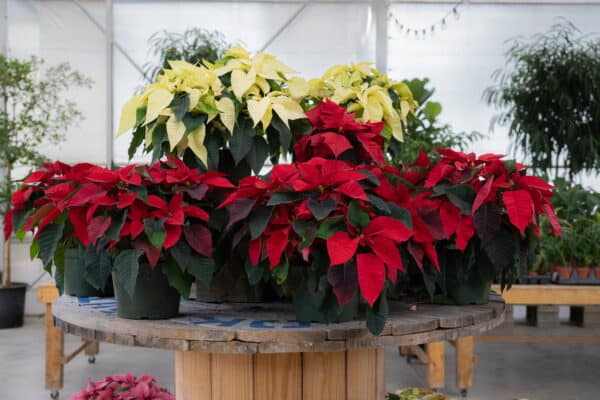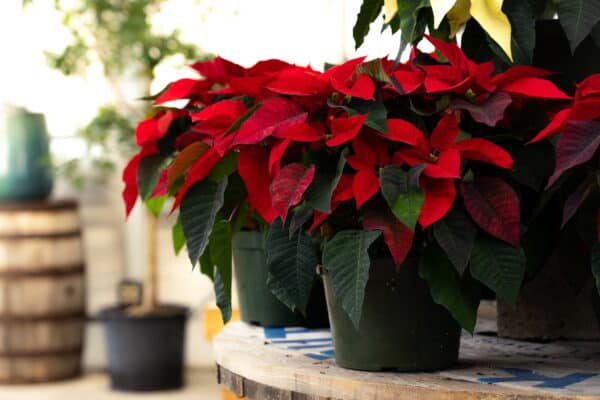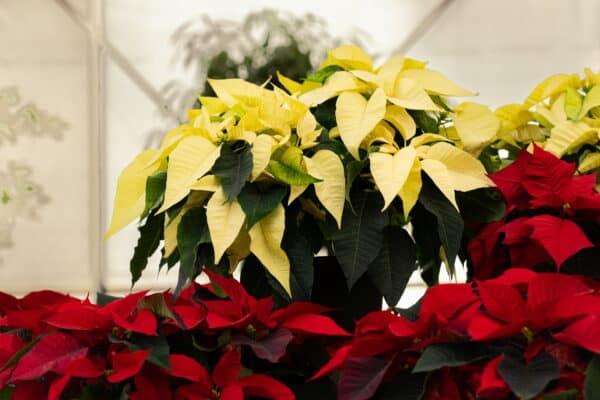How to Care for Poinsettias
By: Frisella Nursery

There’s no potted plant that says Christmas quite like a vibrant red poinsettia. Your Christmas decorations are not complete without one or two of these cheery, brilliantly colored plants around your home.
Poinsettias were first popularized as houseplants in the mid-twentieth century but in their native habitat in Mexico they are actually a shrubby tree. In the wild, they typically bloom in December which naturally made them become a “christmastime plant”.
Nowadays, red poinsettias are still the most popular color, but they also come in a myriad of types including speckles or in fun shades of pink, green, orange, yellow, and plum.
Here are a few tips to ensure that you can enjoy your holiday poinsettias all season long.

Poinsettias like to be warm, so be sure they have plenty of sunlight.
This may seem strange due to their holiday connotations, but poinsettias are tropical plants. As we mentioned earlier, they are native to Mexico. Provide lots of sunlight – a sunny window with east, west or southern exposure will be best. Also try to keep the temperature between 65 and 70 degrees during the day, but keep in mind that an area near a drafty window can be quite a bit cooler than the rest of the room. If your plant’s leaves are touching a cold window, they may drop off as well. At night, poinsettias like a slightly lower temperature, around 55-60 degrees, but avoid drastic drops in temperatures.
How to water Poinsettias
Whenever the surface of the soil feels dry is when you should water your poinsettias. Give the plant a good watering without flooding or soaking it – adding gravel into the bottom of your container will help to keep the plant’s roots dry. If your home tends to be dry during the winter months, a humidifier or a plant mister can help your plants to stay hydrated.
How to prevent leaf loss
If your plant starts to lose some leaves, it could be because of a few different things. Ask yourself these questions: Is the plant resting against a cold window or is it placed in a drafty area? Is it too warm or dry in the room? Is the plant thirsty?
If the leaves of your poinsettia are wilting, and the soil gets dry to the touch, water it right away. Remember that wilting or dropping leaves can also be a sign of overwatering. If the soil is soggy when the leaves fall then you have probably watered it too much.

Encouraging Poinsettias to rebloom
Poinsettias can stay attractive for months if they are properly cared for. However, it can be tricky to get them to rebloom – this is, unless you live in a subtropical area. Then you can transplant them into your outdoor containers or gardens in January, and let the natural changes in daylight trigger their color later in the year. Unfortunately, that is not the case for us here in Missouri.
To coax your plant black into bloom, gradually let it dry out starting in April. Water it just enough to keep the stem from shriveling, and put the plant in a spot that stays about 60 degrees. Then in mid-May, prune the stems to 4 inches high and repot the poinsettias in a slightly larger pot. Move it to a warmer location with good lighting and resume watering. When new growth starts to emerge, fertilize the plant every two weeks with a complete fertilizer.
Pinch back the stems in July and again in mid-August. Poinsettias need about 10 weeks of 12 hours or less or sunlight each day to start showing color. For Christmas flowers, keep the plant in complete darkness from about 5 p.m. to 8 a.m. daily, starting October 1st.
This seems to be too much work for most of us, so don’t feel bad if you just decide to compost your poinsettia after you’ve enjoyed it indoors during the holiday season and pick up a new one next year!

If you have any questions about poinsettias or any other plants please come visit us at Frisella Nursery or give us a call at (636) 798-2555 and one of our Plant Specialists will be happy to assist you!